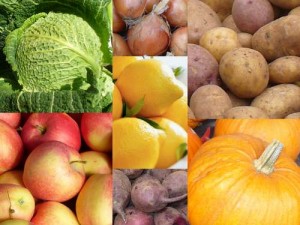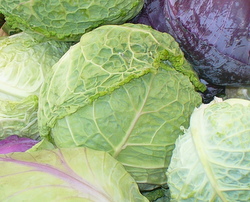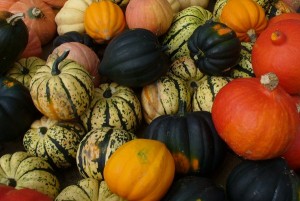 A root cellar is an old-fashioned winter food storage preservation method. In the broadest sense, cellaring is any form of storage that holds food in optimum condition for an extended period by controlling the temperature, humidity, and light. Today’s modern “root cellar” is the refrigerator. However, if you want to maintain a supply of food without the use of electricity, then some knowledge and practice of root cellar preservation methods is useful. No matter where you live, you can use the concept of cellaring to some degree.
A root cellar is an old-fashioned winter food storage preservation method. In the broadest sense, cellaring is any form of storage that holds food in optimum condition for an extended period by controlling the temperature, humidity, and light. Today’s modern “root cellar” is the refrigerator. However, if you want to maintain a supply of food without the use of electricity, then some knowledge and practice of root cellar preservation methods is useful. No matter where you live, you can use the concept of cellaring to some degree.
There are a number of options for storing seasonal crops through winter. The cellaring method depends on your resources as well as on the type of foods to be stored. A food storage cellar does not have to be a stand-alone building or an old-fashioned root cellar in a dirt-floor basement. In the city, you have several options for cellaring food, whether you live in a house, condominium, or apartment. A food storage cellar can also be a cool basement closet, a box buried in the ground, or an attic. If you garden, you may store crops in the ground with heavy mulching.
Types of winter food storage preservation methods
A root cellar is the classic winter storage cellar and existed when houses had unfinished basements with dirt floors. This (lack of) construction made the cellar cool, drafty, and relatively humid. The open, non-insulated root cellar had adequate airflow that despite high humidity, discouraged condensation on the walls. In contrast, a cold room is a finished, but unheated room in some modern homes.
A cold room, unlike the root cellar, is a finished but unheated room in an otherwise warm, dry basement. The basic difference between a root cellar and a basement cold room is the construction. If you have a cold room, or a basement that is partly below ground, you may be able to create a usable cold room. The trick is to design the room as if it is actually an exterior space. The key element of the construction is to insulate the ceiling and interior walls, leave the exterior walls uninsulated, add a vapor barrier on the warm side of the house, and install an insulated exterior door with weather stripping to the cold room. Most importantly, add two screened, adjustable vents that provide a (high) warm-air outlet and (low) cool-air intake. Ensure the floor is a porous material (dirt, cement, or composite deck material are better than wood or linoleum). Finally, build shelving away from the walls to promote air circulation within the room.
Any type of indoor cellar requires a method to control air temperature and relative humidity. Depending on the type of food to be stored, a root cellar or a cold room needs cool temperatures, ranging from 32°F to 60°F, and higher than average humidity—between 60 to 90 percent relative humidity (RH).
Buried containers make a convenient root cellar or cold space for winter food storage, especially root crops. The container should be new or clean, and should not have previously held nonfood items. Suitable containers include new metal or plastic garbage cans and plastic storage bins. Drill holes in the bottom of the container for drainage. Locate the container in an area convenient to your house, but away from garages and car fumes. Dig a hole just large enough to hold the container, with at least 2 inches sticking out above ground level. Load the container with layers of vegetables, separated by straw. Cover the top of the container with 1 to 2 feet of insulating material.
Makeshift cellars are other simple, easy ways to provide additional storage of seasonal crops through winter:
- Basement utility rooms, especially those with a furnace, tend to be warm and dry. This type of room is suitable for some types of vegetables such as winter squashes and onions, as well as dried and canned foods.
- Attic rooms, if they are warm and dry, are well suited to onions, dried vegetables, and dried herbs. If the attic becomes very cold in severe weather, you will need to rotate food to another location. By summertime, if the weather turns hot and humid, winter stored food should be used up.
- An extra energy-efficient refrigerator, while requiring the use of electricity, can also provide a method for long-term storage of locally grown seasonal fruits and vegetables.
Regardless of the type of food storage method used, be sure to monitor the storage environment using a thermometer, as well as a hygrometer that measures relative humidity. Check the produce at least once a month for possible signs of wilting or decay. At least once a year, thoroughly clean and sanitize any type of root cellar or food storage area.
Proper temperature and humidity, and annual cleaning are crucial to reliable long-term storage, and regular monitoring will help you maintain the quality of your food for an entire season of delicious eating.
Types of produce for winter food storage
The tradition of cellaring takes advantage of cold weather, which provides a natural winter food storage environment. In more temperate locations, storage areas need to be given more thought. Either way, the storage methods you use must provide a controlled environment for the types of foods you wish to keep. If you are new to cellaring, you may find that cabbages, onions, potatoes, and root crops are the easiest types of produce to master. If you grow your own vegetables, plant seed varieties recommended for long-term storage. Harvest vegetables early in the morning, on a cold day.
Before you store any produce, sort it for quality. When selecting produce to be stored, always choose firm, mature, unblemished fruits and vegetables, and handle them carefully. Never store any overripe, damaged, or decaying produce in a food storage area; it can contaminate other items if stored nearby. Immediately use or compost overripe produce instead of placing in any type of cellar.
Tips for successful winter food storage: To preserve fresh fruit and vegetable produce successfully, it helps to understand the difference between maturity and ripeness. Maturity means the produce will ripen and become ready to eat after you pick it. Ripeness occurs when the color, flavor, and texture is fully developed. Ripe produce is best for cellaring or cold food storage methods, as well as for fresh eating, drying, or freezing.
Most produce is best stored in mesh bags, baskets, or other containers that allow for plenty of air circulation. Place mature produce gently in clean containers without sharp edges. Note that some produce, such as potatoes and onions have very different storage requirements. Potatoes and onions, along with most types of fruits, don’t make good neighbors in a food storage cellar. Here is a summary of the storage requirements for popular winter vegetables:
 Cabbages keep best when you store it in the garden with heavy mulching, or in an outdoor building hung upside down by their roots from hooks. Cabbage gives off ethylene gas, so do not store cabbage indoors; the odor will fill the house. Cabbage prefers cold (32°F to 40°F), humid (80 to 90 percent RH) conditions.
Cabbages keep best when you store it in the garden with heavy mulching, or in an outdoor building hung upside down by their roots from hooks. Cabbage gives off ethylene gas, so do not store cabbage indoors; the odor will fill the house. Cabbage prefers cold (32°F to 40°F), humid (80 to 90 percent RH) conditions.- Onions and garlic should be conditioned for long storage by “curing” or drying in a well-ventilated place (such as an attic, open shed, or covered porch) for 2 to 3 weeks, or until their outer skins make a rustling sound, indicating they are sufficiently dry for storage. Medium-size red or yellow onions keep longer than large, white, or sweet varieties. Onions and garlic prefer cool (40°F to 50°F), dry (60 to 70 percent RH) rooms. If you garden, onions and garlic (as well as leeks) can also be stored in-ground for several weeks, and can withstand light frosts (to 34°F) with heavy mulching.
- Potatoes should be conditioned for long storage by “curing”. To prepare potatoes for curing, sort and remove any damaged or suspect (soft) potatoes for immediate use. Place firm, unblemished potatoes in a single layer, in the dark (in slightly open paper sacks or loosely covered with newspaper), at 45°F to 60°F for 2 weeks. After curing, store potatoes in a cold (32°F to 40°F), dry (60 to 70 percent RH) location. Store potatoes in complete darkness, such as inside paper bags, covered wooden boxes, tin pails, or buried in dry sand. Sprouting indicates the potatoes are too warm, or are stored next to produce such as onions or apples.
 Pumpkins and winter squashes can be harvested after the vines are killed by a frost. Leave stems on during storage to protect fruit against disease. The best way to store winter squashes is in a cool to warm (40°F to 60°F), dry (60 to 70 percent RH) room. Attics, closets, or near a basement furnace can be excellent alternative locations. Place them individually on shelves or hung in mesh bags.
Pumpkins and winter squashes can be harvested after the vines are killed by a frost. Leave stems on during storage to protect fruit against disease. The best way to store winter squashes is in a cool to warm (40°F to 60°F), dry (60 to 70 percent RH) room. Attics, closets, or near a basement furnace can be excellent alternative locations. Place them individually on shelves or hung in mesh bags.- Root crops, including beets, carrots, celeriac, horseradish, parsnips, rutabagas, salsifies, turnips, and winter radishes, may be stored in-ground for several weeks, and can withstand light freezing (to 28°F) with heavy mulching. You can leave horseradish, parsnip, and salsify in the ground, well mulched until spring; they become sweet in very cold temperatures. Rutabagas, turnips, and winter radishes give off strong odors, so don’t store them indoors. In the cellar, store only beets, carrots, horseradish, parsnips, and salsifies. To store in the cellar, cut off the tops, leaving a 1-inch stem, and place in baskets or boxes. To optimize moisture in dry storage rooms, layer the crops with sand or sphagnum moss. Root crops prefer cold (32°F to 40°F), very humid (80 to 90 percent RH or more) conditions.
- Citrus fruits last longest when stored in cool (40°F to 50°F), dry (60 to 70 percent RH) conditions, in baskets or mesh bags to maximize airflow and prevent mold growth. Oranges can be stored close to freezing (32°F to 34°F).
- Pome fruits, like apples and pears, need to be stored as near freezing (32°F) as possible, in very humid (80 to 90 percent RH or more) conditions. Layer in sand, sawdust, or sphagnum moss; pack into well-ventilated plastic bags; or wrap fruits individually in tissue paper and layer in boxes. If you use plastic bags, routinely examine the bags for condensation; immediately air out bags with visible moisture, or the crop can quickly become moldy and inedible. Apples and pears give off ethylene gas; you may store them together, but away from other crops.
More information about winter food storage and root cellars
For more information about food preservation methods, including winter food storage and building a root cellar, the following resources provide plenty of helpful information.
- Belanger, J. D. The Complete Idiot’s Guide to Self-Sufficient Living. Indianapolis: Alpha Books, 2009. Provides information on gardening, raising livestock, keeping chickens, hunting, fishing, and other practical ideas for sustainable food.
- Cancler, Carole. The Home Preserving Bible, New York: Alpha Books, 2012. A comprehensive guide to food preservation methods with over 300 delicious recipes. Included are detailed instructions for eight methods for preserving foods–using many different techniques and tools both ancient and modern.
- HomePreservingBible.com. Ask questions, find more preserving recipes and techniques, or subscribe to get updates.
- MacKenzie, Jennifer, and Steve Maxwell. The Complete Root Cellar Book. Toronto: Robert Rose, Inc., 2010. Gives detailed, illustrated construction guides for making four different kinds of root cellars.
- Mother Earth News: motherearthnews.com. Online magazine features sustainable living information, including “Build a Basement Root Cellar.”




